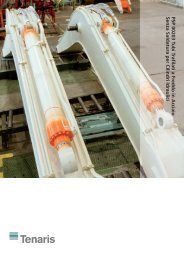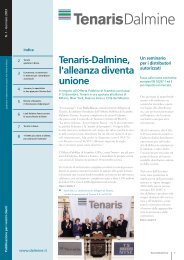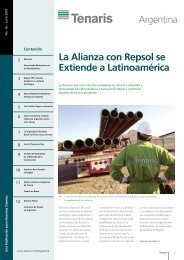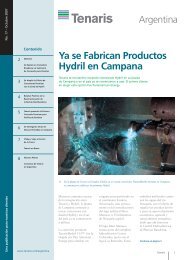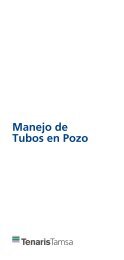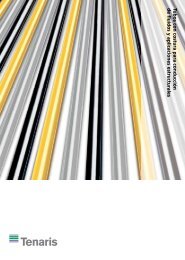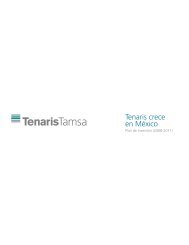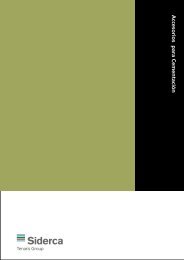Annual Report 2005 - Tenaris
Annual Report 2005 - Tenaris
Annual Report 2005 - Tenaris
Create successful ePaper yourself
Turn your PDF publications into a flip-book with our unique Google optimized e-Paper software.
Explanatory notes<br />
78. <strong>Tenaris</strong>Confab<br />
18. Financial Instruments<br />
The parent company and its subsidiaries engage in transactions<br />
with financial instruments to reduce exposure to<br />
the effects of changes in interest and exchange rates and<br />
other market risks. Transactions observe guidelines established<br />
and monitored by the board of the company.<br />
a. Valuing of financial instruments<br />
The Company's main asset and liability financial instruments<br />
on December 31, <strong>2005</strong> are herein described, together<br />
with the criteria for valuing / evaluating them:<br />
(I) Cash and banks, financial investments, accounts receivable,<br />
other current assets and accounts payable<br />
The amounts accounted for are approximate to those realized.<br />
(II) Investments<br />
These consist mainly of investments in private subsidiaries,<br />
recorded by the equity equivalence method, which are of<br />
strategic interest to the company. The market value of the<br />
shares held is not taken into consideration.<br />
(III) Loans and financing<br />
Subject to normal market interest rates, as described in<br />
Note 11.<br />
b. Risk Management<br />
The main risks the Company and its subsidiaries are<br />
exposed to are of a strategic/operational and<br />
economic/financial nature.<br />
Operational-strategic risks, such as demand behavior, competition<br />
and technology are taken into consideration in the<br />
company's management model.<br />
Economic financial risk reflects mainly the behavior of macroeconomic<br />
variables, such as interest and exchange rates.<br />
Policies and guidelines determined by the company management<br />
forbid speculative negotiation and establish the<br />
diversification of instruments and counterparts. They also<br />
aim to constantly monitor and evaluate the global portfolio<br />
position in order to measure financial results and the<br />
impact on cash flow.<br />
To protect its assets, the company and its subsidiaries<br />
adopt conservative fund raising and financial investment<br />
policies and seek to minimize the cost of capital.<br />
(I) Interest Rate Risk<br />
Interest rate risk comes from that portion of debt contracted<br />
at floating rates. The portion of debt in foreign currency<br />
at floating rates is subject mainly to the oscillations of the<br />
LIBOR-(London Interbank Offered Rate) rate.<br />
The portion of the debt in reais subject to floating rates consists<br />
basically of that subject to Brazilian long term interest<br />
rate (TJLP), determined by the Brazilian Central Bank.<br />
(II) Exchange Rate Risk<br />
The Company monitors the effect of exchange rate oscillations<br />
on its assets and liabilities in foreign currency and on<br />
the commercial flow of contracts on the books and under<br />
negotiation. Additionally, it strives to diversify its financial<br />
investments between domestic and foreign currency (reais<br />
and U.S dollar), in accordance with its working capital and<br />
estimated usage of same. Financial derivative operations<br />
are on occasion used to ameliorate specific risks related to<br />
these positions.



